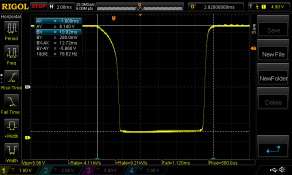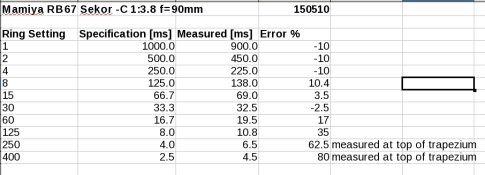Even though I know they already exist, I'm designing a shutter speed tester. My tester design is still in flux at this point, but it will likely use an infrared emitter with a phototransistor as a sensor. At this point, I'm measuring the time with an oscilloscope, but I'll eventually run it from a microcontroller and have the time output displayed with an LED or LCD display.
My problem now is trying to understand the relation between the physical position of the shutter and the shutter speed. In other words, the shutter speed is based on what positions of the shutter?
For example, with a simple blade shutter like a Holga or Diana, at what points would the exposure time be considered to begin and end? First crack of light to last? Shutter halfway open to halfway closed? Fully open to fully closed? In the case of the Holga, from the time I begin to see light at the sensor to no light at the sensor, I've got a time measurement of approximately 14.6 milliseconds, which would translate to a shutter speed of roughly 1/70. Checking my three Dianas, I get roughly 1/50, 1/70, and 1/88. These all seem likely shutter speeds for these cameras, so I'm inclined to think the exposure would be considered as the time from first to last light.
Is it reasonable to think the shutter speed would be based on that time span?
Would it be the same for a leaf shutter?
Would it be the same for a focal plane shutter, or should it be considered the amount of time a specific point on the film sees the open shutter in front of it?
I know these answers are probably pretty straightforward for anyone with a camera design background, but unfortunately, that's not me. I haven't been able to find the answer on the web either. Part of the problem is the 42x10^9 search results explaining shutter speed and how it relates to exposure when you search for anything about camera shutters.
Any help is appreciated!
My problem now is trying to understand the relation between the physical position of the shutter and the shutter speed. In other words, the shutter speed is based on what positions of the shutter?
For example, with a simple blade shutter like a Holga or Diana, at what points would the exposure time be considered to begin and end? First crack of light to last? Shutter halfway open to halfway closed? Fully open to fully closed? In the case of the Holga, from the time I begin to see light at the sensor to no light at the sensor, I've got a time measurement of approximately 14.6 milliseconds, which would translate to a shutter speed of roughly 1/70. Checking my three Dianas, I get roughly 1/50, 1/70, and 1/88. These all seem likely shutter speeds for these cameras, so I'm inclined to think the exposure would be considered as the time from first to last light.
Is it reasonable to think the shutter speed would be based on that time span?
Would it be the same for a leaf shutter?
Would it be the same for a focal plane shutter, or should it be considered the amount of time a specific point on the film sees the open shutter in front of it?
I know these answers are probably pretty straightforward for anyone with a camera design background, but unfortunately, that's not me. I haven't been able to find the answer on the web either. Part of the problem is the 42x10^9 search results explaining shutter speed and how it relates to exposure when you search for anything about camera shutters.
Any help is appreciated!









 )
)



